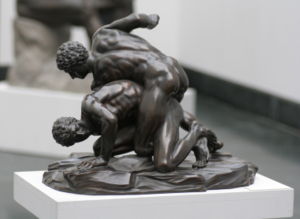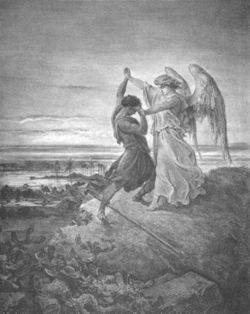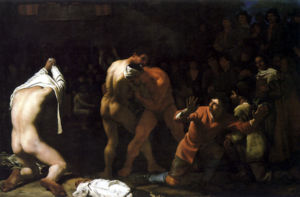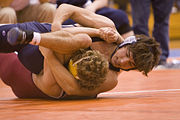Wrestling
2008/9 Schools Wikipedia Selection. Related subjects: Sports
Wrestling is the act of physical engagement between two unarmed persons, in which each wrestler strives to get an advantage over or control of their opponent. Physical techniques which embody the style of wrestling are clinching, holding, locking, and leverage. Avoiding techniques likely to lead to serious injury, ritual fighting, but its basic principles are closely related to those of military hand-to-hand combat or self-defence systems. Many styles of wrestling are known all over the world and have long histories, and sport wrestling (particularly amateur wrestling) has been an Olympic sport for over one hundred years.
History
Ancient
Middle and Far East
The Epic of Gilgamesh in Sumerian literature features its hero Gilgamesh establishing his credibility as a leader after wrestling Enkidu. Other sculptures and literature from ancient Mesopotamia show that wrestling was held in popularity. One other early (probably circa 1500 BC) description of wrestling appears in the Old Testament book of Genesis 32:22-32. The passage depicts the patriarch Jacob wrestling with the Angel, for which Jacob was subsequently renamed Israel. (Israel translates to "wrestles (or strives) with God".)
The Mahabharata, one of the major Sanskrit epics of ancient India, describes the encounter between the accomplished wrestlers Bhima and Jarasandha; "grasping each other in various ways by means of their arms, and kicking each other with such violence as to affect the innermost nerves, they struck at each other's breasts with clenched fists. With bare arms as their only weapons roaring like clouds they grasped and struck each other like two mad elephants encountering each other with their trunks". The popular folk wrestling style of India performed on a mud surface called the akhara follows the Indian tradition.
Shuai Jiao, a wrestling style originating in China, is arguably the most ancient of all Chinese martial arts, with a reported history of over 4,000 years. (The date may be legendary, but wrestling was reportedly used by the Yellow Emperor during his fight against the rebel Chih Yiu and his army in 2697 BC.) During these matches, the combatants reportedly wore horned helmets that they used to gore their opponents while using a primitive form of grappling. This early style of combat was first called Jiao Ti (butting with horns). Throughout the centuries, the hands and arms replaced the horns while the techniques increased and improved. The name Jiao Ti also changed over time, both through common usage and government decree.
Mediterranean
The first documented evidence of wrestling in Egypt appeared circa 2300 BC, on the tomb of the Old Kingdom philosopher Ptahhotep. During the period of the New Kingdom (2000-1085 BC), additional Egyptian artwork (often on friezes), depicted Egyptian and Nubian wrestlers competing. Carroll notes striking similarities between these ancient depictions and those of the modern Nuba wrestlers. On the 406 wrestling pairs found in the Middle Kingdom tombs at Beni Hasan in the Nile valley, nearly all of the techniques seen in modern freestyle wrestling could be found. During the period of Ancient Greece (about 1100 to 146 BC), Greek wrestling was a popular form of martial art in which points were awarded for pinning a competitor by stretching the opponent prone to the ground or touching his back to the ground, forcing a competitor to submit or by forcing a competitor out of bounds (arena). Three falls determined the winner. It was at least featured as a sport since the eighteenth Olympiad in 704 BC. Wrestling is described in the earliest celebrated works of Greek literature, the Iliad and the Odyssey. Wrestlers were also depicted in action on many vases, sculptures, and coins, as well as in other literature. Other cultures featured wrestling at royal or religious celebrations, but the ancient Greeks structured their style of wrestling as part of a tournament where a single winner emerged from a pool of competitors. Greek mythology celebrates the rise of Zeus as ruler of the earth after a wrestling match with his father, Cronus. Both Heracles and Theseus were famous for their wrestling against man and beast. Late Greek tradition also stated that Plato was known for wrestling in the Isthmian games.
This continued into the Hellenistic period. Ptolemy II and Ptolemy III of Egypt were both depicted in art as victorious wrestlers. After the Roman conquest of the Greeks, Greek wrestling was absorbed by the Roman culture and became Roman wrestling during the period of the Roman Empire (510 BC to AD 500). Arabic literature depicted Muhammad as a skilled wrestler, defeating a skeptic in a match at one point. By the eighth century, the Byzantine emperor Basil I, according to court historians, won in wrestling against a boastful wrestler from Bulgaria.
Middle Ages
In 1520 at the Field of the Cloth of Gold pageant, Francis I of France threw Henry VIII of England in a wrestling match. In Henry VIII's kingdom, folk wrestling in many places was widely popular and had a long history. In particular, the Lancashire style may have formed the basis for Catch wrestling also known as "catch as catch can." The Scots later formed a variant of this style, and the Irish developed the "collar-and-elbow" style which later found its way into the United States. The French developed the modern Greco-Roman style which was finalized by the 19th century and by then, wrestling was featured in many fairs and festivals.
Modern
Because of that and the rise of gymnasiums and athletic clubs, Greco-Roman wrestling and modern freestyle wrestling were soon regulated in formal competitions. On continental Europe, prize money was offered in large sums to the winners of Greco-Roman tournaments, and freestyle wrestling spread rapidly in the British Isles and in the United States after the American Civil War. Professional wrestling soon increased the popularity of Greco-Roman and freestyle wrestling around the world with such competitors as Georg Hackenschmidt, Kara Ahmed, Paul Pons, Stanislaus Zbyszko, William Muldoon, and Frank Gotch. When the Olympic games resurfaced at Athens in 1896, Greco-Roman wrestling was introduced for the first time. After not being featured in the 1900 Olympics, sport wrestling was seen again in 1904 in St. Louis; this time in freestyle competition. Since then, Greco-Roman and freestyle wrestling have both been featured, with women's freestyle added in the Summer Olympics of 2004. Since 1921, the International Federation of Associated Wrestling Styles (FILA) has regulated amateur wrestling as an athletic discipline, while professional wrestling has largely become infused with theatrics but still requires athletic ability.
Etymology
The term wrestling is an Old English word that originated some time before 1100 A.D. It is perhaps the oldest word still in use in the English language to describe hand-to-hand combat. The Merriam-Webster online dictionary defines wrestling as "a sport or contest in which two unarmed individuals struggle hand-to-hand with each attempting to subdue or unbalance the other".
Roget's New Millennium Thesaurus does not support the usage of 'wrestling' (noun) and 'grappling' (noun) as synonymous.
International disciplines (non-folk styles)
Wrestling disciplines defined by FILA, are broken down into two categories; International wrestling disciplines and folk wrestling disciplines. According to the International Federation of Associated Wrestling Styles, there are five current International wrestling disciplines acknowledged throughout the world. They are Greco-Roman Wrestling, Freestyle Wrestling, Grappling, Beach wrestling and Sambo.
Greco-Roman
Greco-Roman is an international discipline and an Olympic sport. "In Greco-Roman style, it is forbidden to hold the opponent below the belt, to make trips, and to actively use the legs in the execution of any action." Recent rule changes in Greco-Roman increase opportunities for and place greater emphasis on explosive, 'high amplitude' throws. One of the most well known Greco-Roman wrestlers is Alexander Karelin from Russia.
Grappling
"Grappling is a wrestling style also called submission wrestling or “submission grappling” which consists of controlling the opponent without using striking, in standing position or on the ground after a throw, and to make him or her abandon thanks to immobilisation techniques such as locks. Grappling plays an important role in the practice of Mixed Martial Arts (MMA) and can be used as a self-defence technique. It brings together techniques from Brazilian jiu-jitsu (no-Gi), Freestyle Wrestling, Folk American Wrestling (catch-as-catch-can), Sambo and judo.". Grappling is also used to describe the skills used in mixed martial arts competitions, differing from the FILA definition. Grappling can be trained for self defense, sport and mixed martial arts ( MMA) competition.
Beach wrestling
Apparently in a bid to give wrestling greater appeal to television audiences, FILA adopted beach wrestling as an official discipline during 2004-2005. Beach wrestling is standing wrestling done by wrestlers, male or female, inside a sand-filled circle measuring 6 meters (20 ft) in diameter. There are only two weight categories, heavy and light. The objective is to throw your opponent or take your opponent to his or her back. The wrestlers wear swimsuits rather than special wrestling uniforms. Wrestlers may also wear spandex or athletic shorts.
Sambo
Sambo is a martial art that originated in the Soviet Union (particular Russia) in the 20th century. It is an acronym for "self-defence without weapons" in Russian and had its origins in the Soviet armed forces. Its influences are varied, with techniques borrowed from sports ranging from the two international styles of Greco-Roman and freestyle to judo, jujutsu, European styles of folk wrestling, and even fencing. The rules for sport sambo are similar to those allowed in competitive judo, with a variety of leglocks and defense holds from the various national wrestling styles in the Soviet Union, while not allowing chokeholds.
Folk style disciplines
Folk wrestling describes a traditional form of wrestling unique to a culture or geographic region of the world. There are almost as many folk wrestling styles as there are national traditions. Folk style is also used across the United States in high school wrestling. Folk style is competed state wide in all states. Some states wrestle in classes depending on how large each school is. Others states have large tourneys that each individual has to win or place in order to move on to the final tourney, the State Championship. The sport allows mostly males to wrestle, although women are slowly introducing themselves to high school wrestling. Folk style is also held state wide in some states through the states wrestling associations. Holding tourneys on weekends for anyone of all ages to participate.
Examples of folk styles include Backhold Wrestling (from Europe), Catch-as-catch-can (from England), Kurash from Uzbekistan, Gushteengiri from Tajikistan, Khuresh from Siberia, Lotta Campidanese from Italy, Pahlavani from Iran, Pehlwani from India, Penjang Gulat from Indonesia, Schwingen form Switzerland, Shuai jiao from China, Ssireum from Korea, and Yağlı güreş (Turkish oil wrestling).
Folk wrestling styles are not recognized by FILA internationally.
Collegiate wrestling
Collegiate wrestling (sometimes known as scholastic wrestling or folk style wrestling) is the commonly used name of wrestling practiced at the college and university level in the United States. A modification of the style is practiced at the high school and middle school levels, and also for younger participants. The term is used to distinguish the styles of wrestling used in other parts of the world, and for those of the Olympic Games: Greco-Roman wrestling, and Freestyle wrestling. There are currently several organizations which oversee collegiate wrestling competition: Divisions I, II, and III, of the NCAA, NJCAA, NAIA, and the NCWA. Division I of the NCAA is considered the most prestigious and challenging level of competition. A school chooses which organization to join, although it may compete against teams from other levels and organizations during regular-season competition. The collegiate season starts in November and culminates with the NCAA tournament held in March.
Puroresu
Japanese professional wrestling, also known as puroresu, is treated as a sport rather than the entertainment style of wrestling found in North America. There are no storylines, feuds or any sort of angle found in puroresu. The matches are all about athleticism and skill. Another technique found in puroresu is that most of the wrestlers use shoot style strikes and complex submission moves. This means that the wrestlers are more prone to injury. Popular Japanese wrestlers include Kenta Kobashi, Tiger mask, The Great Muta, Jun Akiyama, Jushin "Thunder" Liger, and KENTA.







